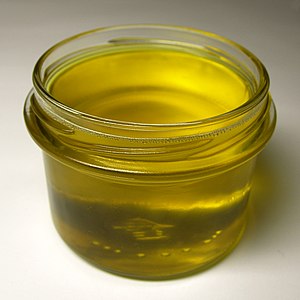Cookbook:Clarified Butter
| Clarified Butter | |
|---|---|
 | |
| Category | Fats and oils |
Cookbook | Recipes | Ingredients | Equipment | Techniques | Cookbook Disambiguation Pages | Ingredients
Clarified butter, also called ghee, is made by purifying (or clarifying) butter to remove the milk solids and water.[1] Typically, this is done by heating the butter to force the separation of the pure butterfat from the other components.
Characteristics
[edit | edit source]When heated, clarified butter is a golden-yellow liquid, and it will solidify into a pale, granular texture when cooled. Due to the removal of the milk solids, clarified butter has a high smoke point of about 450°F (compared to regular butter's smoke point of about 350°F).[2] Clarified butter can also be stored longer than regular butter without rancidity or off flavors.[1]
Preparation
[edit | edit source]Clarified butter is typically made in one of two ways. The first method involves melting the butter, skimming the foam off the surface, and collecting the butterfat layer without disturbing the water underneath—this method works best when clarifying large amounts of butter. The second method involves heating the butter until all the water boils away, then straining through a fine mesh to remove the milk solids.[2][3]
In Yemen, when butter was historically produced at home, ghee was made by adding hot water to the churn containing the cream, which helped the butter congeal. When the butter was removed from the churn and put into a different vessel, wheat flour or ground fenugreek seeds mixed with wheat flour were then added, and the whole was cooked together over a fire. The butter was then strained, put into a vessel and stored.[4]
Use
[edit | edit source]Due to its high smoke point, clarified butter is good for use in high-heat cooking, such as frying or sautéing.[1][2] It can also be used in baking recipes that require high smoke point fats.
Ghee is used heavily in Indian cuisine. In some East African societies, butter was flavored by adding crushed garlic, fenugreek, turmeric, cardamom, and ginger and cooking over a low heat.
Recipes
[edit | edit source]References
[edit | edit source]- ↑ a b c "Clarified Butter - Joyofbaking.com". www.joyofbaking.com. Retrieved 2024-04-08.
- ↑ a b c "What Is Clarified Butter?". Food Network. Retrieved 2024-04-08.
- ↑ "Clarified Butter Recipe". Serious Eats. Retrieved 2024-04-08.
- ↑ Badiḥi, Yiḥya (2011). Yosef Ḥen (ed.). Ḥen Ṭov (in Hebrew). Bene Berak: Nosaḥ Teman. p. 206 (responsum no. 48–beth). OCLC 768305430.